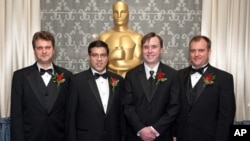The Academy Awards, or Oscars, will be handed out Sunday, but the inventors and engineers who make movies possible have already been honored. This year's scientific and technical awards were presented earlier this month by the Academy of Motion Picture Arts and Sciences.
“There wouldn’t be any movies without technology. And it’s becoming more and more amazing what technology is being invented for making movies," said Richard Edlund, who has won Oscars for visual effects in Stars Wars, The Empire Strikes Back, Raiders of the Lost Ark and Return of the Jedi, and he chairs the Academy’s Sci-Tech committee.
The Academy is a professional organization of actors and filmmakers who say that making films is both an art and science. And it hands out awards for technical and scientific achievements in film.
Academy certificates and plaques plus a few Oscars were handed out earlier this month for those achievements.
This year, an award went to Uwe Weber, honored with his late colleague Jurgen Noffke, for creating sensitive low-distortion lenses jointly produced by the ARRI and Zeiss companies.
“Yes, it’s possible to shoot in low light, candle light or so on, and this makes it very special. You can get very natural images by that,” Weber explained.
The ARRI Zeiss lenses helped create the fantasy world in the Lord of the Rings trilogy.
Richard Toftness and his colleagues were honored for creating the Phantom line of high-speed digital cameras. Their cameras create incredibly slow motion on the screen, seen in many recent films, says team member Andy Jantzen.
“The latest one was Sherlock Holmes..... I was told two days ago that it was used in the Matrix film,” Jantzen said.
Richard Toftness says the cameras add texture to movies.
“We’ve been told that 95 percent of the films that use slow-motion effects use our cameras,” Toftness noted.
Bob Nettmann and his colleagues were honored for creating stabilizers for cameras and lenses for shooting from helicopters, cars, cranes and boats. They were used in the film Mission Impossible to show Tom Cruise rappelling off a building.
“Our work is our hobby, so it’s a paying hobby. We’re stressed out at the moment because we’re building stuff for the Olympics, the London 2012 Olympics,” Nettmann said.
The team's products will help Olympic viewers get a closeup view of events.
Kimball Thurston was honored with his colleagues and late team leader John Lowry for an image-enhancing system called the Lowry Process . It's been used to improve the look of classic films like Gone With The Wind and more recently, Avatar.
“I’m extremely honored, obviously, very excited. A little bit nervous," Thurston said adding that he's seldom in the limelight.
Industry veteran, Jonathan Erland, was honored with a special medal for his service to the movie academy. He says digital technology provides new ways to make and watch movies.
including on computers and mobile devices. But he likes to watch them the old-fashioned way, in a theater.
“Even though we have lots of ways to look at movies at home, the preferred way is still to go to a theater just the way we’ve been doing it for 100 years," Erland said.
Movie Academy Honors Inventors, Engineers












